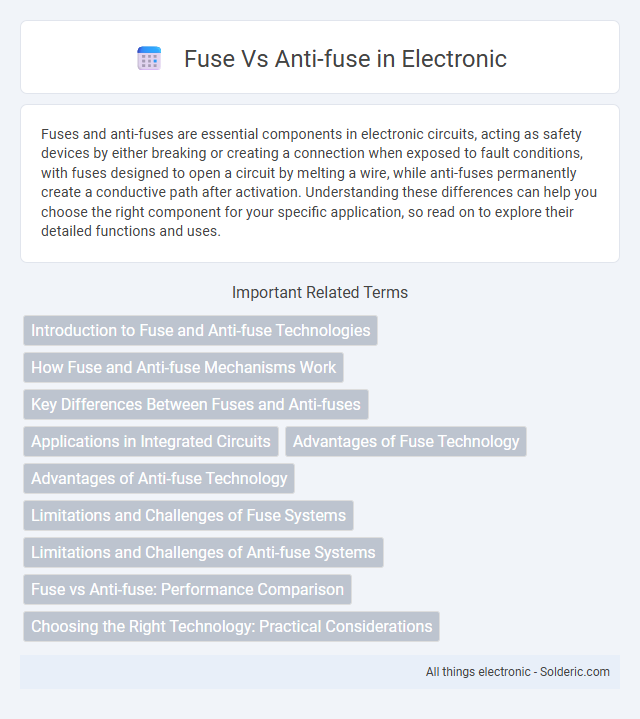Fuses and anti-fuses are essential components in electronic circuits, acting as safety devices by either breaking or creating a connection when exposed to fault conditions, with fuses designed to open a circuit by melting a wire, while anti-fuses permanently create a conductive path after activation. Understanding these differences can help you choose the right component for your specific application, so read on to explore their detailed functions and uses.
Comparison Table
| Feature | Fuse | Anti-fuse |
|---|---|---|
| Definition | A component that creates a permanent conductive path when blown. | A component that creates a permanent conductive path when triggered (initially non-conductive). |
| Initial State | Conductive (closed circuit). | Non-conductive (open circuit). |
| Operation | Blows/open circuit under high current to protect devices. | Switches to conductive under high voltage or current (programming). |
| Reversibility | Irreversible after blowing. | Irreversible after programming. |
| Applications | Overcurrent protection in circuits. | One-time programmable memory, circuit configuration. |
| Physical Nature | Metal wire or strip. | Dielectric material between electrodes. |
| Failure Mode | Open circuit (break). | Closed circuit (short). |
Introduction to Fuse and Anti-fuse Technologies
Fuse and anti-fuse technologies are fundamental in programmable logic devices and integrated circuits, enabling circuit customization through distinct mechanisms. Fuses rely on electrically blowing a metal link to create an open circuit, while anti-fuses use a dielectric breakdown to form a permanent conductive path. Both technologies are critical for applications requiring one-time programmable logic or security features in embedded systems.
How Fuse and Anti-fuse Mechanisms Work
Fuse mechanisms operate by creating an open circuit through a physical break in a conductive material, effectively interrupting electrical flow to protect circuits from damage. Anti-fuse technology functions oppositely by starting as an open circuit that becomes permanently conductive when a high voltage is applied, forming a low-resistance connection. These contrasting mechanisms enable precise control in programmable devices, with fuses disabling pathways and anti-fuses enabling permanent connections.
Key Differences Between Fuses and Anti-fuses
Fuses and anti-fuses serve opposite functions in electrical circuits: fuses are designed to break a circuit by melting a conductive element when excessive current flows, providing overcurrent protection, while anti-fuses create a permanent conductive path when triggered, enabling one-time programmable connections in devices like FPGAs. The key difference lies in their operational states--fuses start as conductive and become non-conductive after activation, whereas anti-fuses begin non-conductive and become conductive once activated. Understanding these distinctions helps you choose the appropriate component based on whether your application requires circuit interruption or permanent electrical connection.
Applications in Integrated Circuits
Fuse technology in integrated circuits is typically used for programmable read-only memory (PROM) and redundancy in memory arrays, enabling permanent, one-time programmable connections for device customization and fault correction. Anti-fuse technology offers non-volatile programmable connections with higher density and lower resistance, making it ideal for field-programmable gate arrays (FPGAs) and secure key storage. Both technologies are critical for customizing IC functionality and enhancing device reliability in semiconductor manufacturing.
Advantages of Fuse Technology
Fuse technology offers high reliability and predictable electrical behavior, making it ideal for integrated circuits and memory applications. It enables easy programmability and reprogrammability without complex manufacturing processes, reducing production costs and time. The technology also provides excellent tolerance to environmental variations, enhancing device stability and longevity.
Advantages of Anti-fuse Technology
Anti-fuse technology offers permanent, high-density interconnections with virtually zero resistance and minimal signal delay, making it ideal for secure, non-volatile configurations in field-programmable gate arrays (FPGAs). Its one-time programmable nature provides enhanced resistance to tampering and radiation, ensuring reliable operation in aerospace and military applications. Anti-fuse devices also consume lower static power compared to fuse-based counterparts, contributing to energy-efficient designs.
Limitations and Challenges of Fuse Systems
Fuse systems face limitations such as limited scalability and difficulty in reliably programming and reprogramming circuits compared to anti-fuse technology, which offers one-time programmable connections. The volatility of fuse elements can lead to unintentional blowouts caused by electrical surges or environmental factors, reducing overall system reliability. Your circuit design may encounter challenges in integrating fuse systems where precise and irreversible programmability is required, impacting long-term flexibility.
Limitations and Challenges of Anti-fuse Systems
Anti-fuse systems face significant limitations due to their irreversible programming, which restricts reusability and flexibility in configuration changes after initial activation. These systems are also challenged by high programming voltages and susceptibility to process variations, potentially impacting reliability and manufacturing yields. Furthermore, anti-fuse technology often involves more complex fabrication processes, leading to increased costs compared to traditional fuse counterparts.
Fuse vs Anti-fuse: Performance Comparison
Fuse and anti-fuse technologies differ significantly in performance characteristics, with fuse devices exhibiting fast programming times and reversible operation, while anti-fuse devices offer permanent, one-time programmability with superior resistance to environmental factors. Anti-fuses provide lower resistance and higher reliability in harsh conditions, making them ideal for aerospace and military applications, whereas fuses are preferred in applications requiring occasional reprogramming and flexibility. Understanding these differences helps you select the optimal solution based on speed, durability, and reconfigurability requirements.
Choosing the Right Technology: Practical Considerations
Fuse technology offers reprogrammability and easier correction of errors, making it suitable for applications requiring flexibility and iterative design changes. Anti-fuse technology provides permanent, one-time programmable connections with higher reliability and resistance to radiation, ideal for secure and mission-critical environments. Your choice between fuse and anti-fuse should consider factors such as reprogramming needs, environmental robustness, and application-specific reliability requirements.
Fuse vs Anti-fuse Infographic

 solderic.com
solderic.com